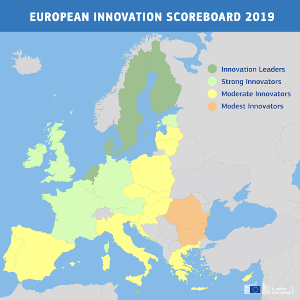The innovation graveyard
Published on 30 11 2019Blog Roderik Sorbi – Senior Client Consultant
It’s our third year running, and we have spoken to dozens of marketers, CMO’s, innovation managers and marketing directors. This year’s Brand Growth theme covers the role of innovation in brand growth. As of now, 24 interviews have been published on the Brand Growth platform. So, what can we take out of all the conversations we’ve had? Here are my take-outs.
Innovation leader
But first, let’s start with some interesting news. In a recent study conducted by the European Commission, the Netherlands is ranked as one of the most innovative countries in the EU. According to the European Innovation Scoreboard rankings of 2019, we are labelled as an innovation leader. Just missing out on the Top 3, consisting of our neighbours up North: Sweden takes first place, followed by Finland and Denmark in second and third. So, that’s something to keep in mind.

1 Timing is everything
Now, let’s look at the interviews. The first thing I noticed and was reconfirmed to me, is that timing is mentioned as one of the most crucial elements in innovation. There is not only being talked about developing or launching an innovation too late. Innovations often fail because they were too early. They either followed a trend that hasn’t reached the market yet, or the consumer was simply not ready for it at the time.
2 The graveyard
In the interviews there was an overarching feeling among marketers that when they come up with ideas (they don’t have to be concepts, just ideas) a lot of time and energy is put into them. But, when it appears to not have enough substance, or doesn’t resonate well enough with the consumer, they are thrown out. They are put five feet under, and won’t see the light of day ever again.
The friction
These 2 findings appear to have the same friction. On one hand, you can be too early, but on the other, a lot of time and energy is put into these ideas, and when they don’t score well, they get dropped. The problem might not be that the idea doesn’t resonate enough with the consumer, but more to do with the moment you screen them. This argues the thought that testing your ideas, shouldn’t be a one-off. Those ‘old’ ideas that didn’t quite make it before, should be tested to check if the time is right to accelerate and benefit from that momentum.
Scratching the surface
From the conversations we’ve had with top marketers from a lot of different industries, we see that innovations that didn’t hold that great of a potential before, can certainly be successful now. A reason might be the constantly changing market. There are massive trends among us that were barely scratching the surface 2 years ago. People’s eating patterns for instance, have been changing rapidly these past few years (which I for instance noticed in the interview I had with HAK). Healthy and vegetarian diets have become more mainstream (which was underlined in the interview with Hero). Soft drinks for adults like for example Finley have had an enormous uplift, whilst not too long-ago similar product ideas weren’t making it onto the market.
Discovering future potential
Marketers and innovation managers should look into a system where old and new ideas are validated at least once a year. Ideas that went down the drain originally, should be tested every year to see if the market is ready for it now. Otherwise, you risk throwing something away that could hold potential in the near future, and has been invested a lot of time in. The strength of validating older ideas not only prevents throwing away potentials, but also allows for efficiency in your innovation process.
A lot of idea screening techniques are based on simple KPI’s such as buying intention. Which says something about the short-term results of ideas that are close to home. A new fruit flavour of Fanta will naturally score higher because it is closer to the current proposition. But innovative propositions – because they are new and different – will score significantly lower, but can certainly hold potential. That’s why we use a validated technique called acceptor-rejector, which provides a much better picture of the short- and long-term effects of the adaptation of an idea.
The greatest potential
Whatever the circumstances, we know they are prone to change in a rapid pace. In one of our interviews from July, there was said that a lot of people are ahead of their time (The Avocado Show). And I agree. Some ideas are pre-mature, and shouldn’t be given a spot in the cemetery just because they haven’t got the time to properly age. Whilst their greatest potential is just waiting to be shared in the future. Shouldn’t be too difficult, with our small country being an innovation leader and all.